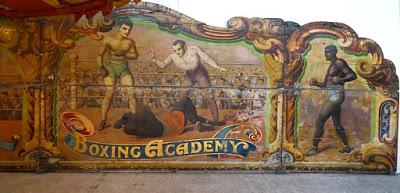 Dingle's Fairground Heritage Centre is full of eye-catching fairground art, as well as actual working rides. Among its many striking pieces is one which tells all sorts of stories: a set of panels from the elaborately-painted Billy Wood's Boxing Show.
Dingle's Fairground Heritage Centre is full of eye-catching fairground art, as well as actual working rides. Among its many striking pieces is one which tells all sorts of stories: a set of panels from the elaborately-painted Billy Wood's Boxing Show. 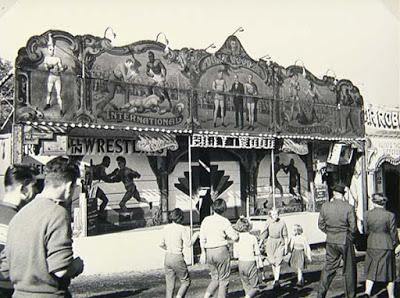
The boxing show was a familiar attraction in British funfairs until the 1970s. Members of the public would be promised a pound if they could win three rounds with one of the professional boxers who took on all-comers. Few of them succeeded! Of course, some fights were easier for the professionals than others: Danny Corns recollects how, when Billy Wood's would visit Ilston Fair, 'Half a dozen booth fighters who toured with the show would stand in a line on the booth platform where the showman would introduce them one by one... [After pub closing-time] the inebriated challenger, arms flailing like a windmill, only managed to hit fresh air. The fair boxer usually took it easy on him. The challenger soon became exhausted and struggled to get off his stool for the next round.' A number of pre-war boxers began their careers in these shows, and the incredible demands of the fairground must have provided a good grounding for the gruelling schedules endured by many of those professional boxers.
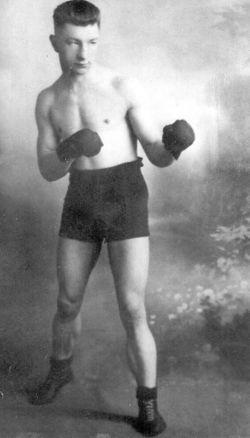
Billy Wood was the son of a boxing show operator and grandson of a bare-knuckle fighter. Born in Scotland in 1903, he first appeared in his father's fairground show aged nine, but his career really begin in 1919. He later described a day at the 1919 Durham Miners' Gala which began at 7am, ended at 1am, and involved fighting 18 miners (15 were knocked out).
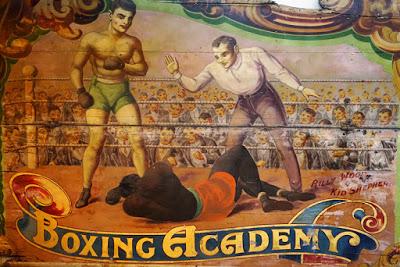
Wood's boxing show began in 1922, when he was just 19. Since the panel shows a 1931 fight, it may have been repainted soon after his move from Scotland to England in 1929. Wood fought in the fairgrounds during the summer and in boxing venues during winter. The fight between him and 'Kid Shepherd' depicted on his booth was one of the latter. It is an intriguing choice: it is not obvious that this match was particularly significant. It may, though, have been a career highlight for Wood, not least because it was his second win in two days. Following a drawn match just a fortnight earlier, he won this rematch with a knock-out. Incredibly, the day before the rematch with Sheppard in Leith, he had fought in Hackney - and also won. Yet those efforts were perhaps overshadowed by his win against Johnny McMillan three months later, since it made him featherweight champion of Scotland. When his boxing career ended, he dedicated himself full-time to the show which last appeared at the Nottingham Goose Fair in 1971. (By then, changes in culture, safety regulations, and British Boxing Board of Control rules which prevented professionals fighting in the fairgrounds, had all contributed to the booths' decline.) His sons then gave it to the National Fairground Trust, and it is a highlight of their collection on display at the Heritage Centre.
However, the story of his opponent Arnold 'Kid' Sheppard is a rather tragic one. Born in Cardiff Docks in 1908 to a Barbadian father and British mother, he had worked as a miner in the Rhondda Valley before he fought Billy Wood twice in 1929, in Leith. He was knocked out in the first match but a fortnight later, they fought again and drew on points. These were just two of around 300 bouts in a career stretching from 1926 to 1939: an average of over 20 fights a year, meaning that he often went into the ring still injured from a previous match. He was a 'journeyman', who prided himself on lasting the distance in most fights even though he 'often fought hurt and on very short notice.' Nonetheless, he won 95 of the fights and drew 38. There is some information online about Sheppard's bleak retirement (thankfully, it seems that his life and career are now being researched). He joined the merchant navy in World War II; but in later life he suffered blindness and dementia as a result of his boxing injuries, and he died in Claybury Asylum, Essex in 1979.

One reason for Sheppard's punishing fight schedule may have been that the opportunity to fight for a Lonsdale title belt, and thus enjoy a more lucrative career, was closed to him. Black boxers had been an integral part of the fairground and professional fighting scenes since the nineteenth century, but from 1911 to 1948, 'non-white' boxers were formally barred from Lonsdale championship titles.
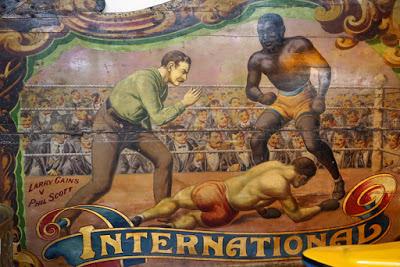
The other match was a more obviously notable one: Canadian fighter Larry Gains, the 'Toronto Terror', had beaten Phil Scott to win the British Empire Heavyweight Title in 1931 - but the British Boxing Board of Control refused to recognize him as champion because of the color bar. (PJ Moss, writing in the Daily Mirror, suggested that fans viewed Gains as champion: 'When a champion is beaten under championship conditions the public generally regard the winner as taking over the mantle of the defeated one.') Scott had won his previous three fights for the title; Gains would hold it (or not) in another three fights before losing to Len Harvey in 1934. The bar on black boxers also prevented him from becoming World Champion (giving him the title for his autobiography, The Impossible Dream), though he did twice win the title of Coloured Heavyweight Champion of the World. He went on to be a physical training instructor in the British Army during World War II. After the war, he lived in and around London and did a series of low-paid jobs, having lost much of his money through gambling. Meanwhile, Scott didn't fight again but became a boxing instructor for the Egyptian police.
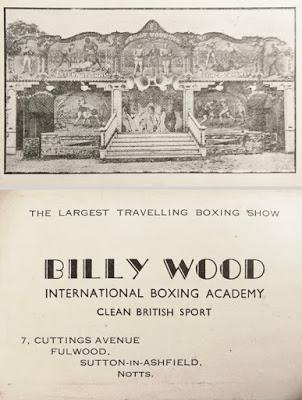
Knowing a little of the background to these images leaves us with many questions. Why do both illustrations show fights between a black man and a white man? How were they read by fair-goers, and how did Wood intend them? Promotional cards for Wood's boxing academy featured an image of the booth on one side; the other included the slogan 'clean British sport', firmly encompassing these black men within both Britishness and sporting virtues. Was this simply a reflection of their established place in fairground boxing, or a more deliberate comment on the racism elsewhere in the sport?

